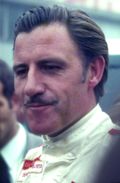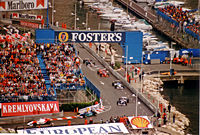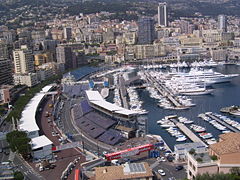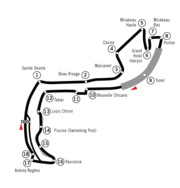Monaco Grand Prix
2008/9 Schools Wikipedia Selection. Related subjects: Sports events
| Circuit de Monaco | |
 |
|
| Race information | |
| Laps | 78 |
|---|---|
| Circuit length | 3.340 km (2.075 mi) |
| Race length | 260.520 km (161.887 mi) |
| First held | 1929 |
| Last held | 2008 |
| Most wins (drivers) | |
| Most wins (constructors) | |
| Last race ( 2008): | |
| Pole position | Ferrari 1:15.787 |
| Podium | 1. McLaren- Mercedes 2h 00m 42.742s (126.170 km/h) 2. BMW Sauber +3.064s 3. Ferrari +4.811s |
| Fastest lap | Ferrari 1:16.689 |
The Monaco Grand Prix (Grand Prix de Monaco) is a Formula One race held each year on the Circuit de Monaco. Run since 1929, it is widely considered to be one of the most important and prestigious automobile races in the world alongside the Indianapolis 500 and the 24 Hours of Le Mans (with which it forms the Triple Crown of Motorsport). The history, spectacle and glamour result in the race being considered "the jewel of the Formula One crown".
The first race in 1929, was organised by Anthony Noghès under the auspices of the "Automobile Club de Monaco", and was won by William Grover-Williams driving a Bugatti. The event was part of the pre-Second World War European Championship and was included in the first Formula One World Championship in 1950. The race is held on a narrow course laid out in the streets of Monaco, with many elevation changes and tight corners, making it one of the most demanding tracks in Formula One. In spite of the relatively low average speeds, it is a dangerous place to race.
Brazil's Ayrton Senna has won the race more times than any other driver, with six victories, winning five consecutively between 1989 and 1993. Graham Hill was known as "Mr Monaco" due to his five Monaco wins in the 1960s.
History
Origin
Like many European races, the Monaco Grand Prix predates the current World Championship. The principality's first Grand Prix was organised in 1929 by Anthony Noghès, under the auspices of Prince Louis II, through the Automobile Club de Monaco (ACM). Alexandre Noghès, Anthony's father, was founding president of the ACM, originally named Sport Vélocipédique Monégasque. The ACM made their first foray into motorsport by holding the Rallye Automobile Monte Carlo from 1911. In 1928 the club applied to the Association Internationale des Automobiles Clubs Reconnus (AIACR), the international governing body of motorsport, to be upgraded from a regional French club to full national status. Their application was refused due to the lack of a major motorsport event held wholly within Monaco's boundaries. The rally could not be considered as it mostly used the roads of other European countries.
In order to attain full national status, Noghès proposed the creation of an automobile Grand Prix in the streets of Monte Carlo. Noghès obtained the official support of Prince Louis II. Noghès also gained support for his plans from Monegasque Louis Chiron, a top-level driver in European Grand Prix racing. Chiron thought that the topography of the location would be well suited to setting up a race track.
The first Grand Prix Automobile de Monaco was an invitation only event, but not all of those invited decided to attend. The leading Maserati and Alfa Romeo drivers decided not to compete but Bugatti was well represented. Mercedes sent their leading driver, Rudolf Caracciola, to drive a Mercedes SSK. Caracciola drove a fighting race, bringing his SSK up to second position at the end of the race, despite starting in fifteenth. The race was won by "Williams" (pseudonym of expatriate Briton William Grover-Williams) driving a Bugatti Type 35B painted in what would become the famous British racing green. Another driver who competed using a pseudonym was " Georges Philippe", the Baron Philippe de Rothschild. Chiron was unable to compete, having a prior commitment to compete in the Indianapolis 500 on the same day. However, Chiron did compete the following year, finishing second, and took victory in the 1931 race driving a Bugatti. As of 2007, he remains the only native of Monaco to have won the event.
Pre-war
The race quickly grew in importance. Because of the large number of races which were being termed 'Grands Prix', the AIACR formally recognised the most important race of each of its affiliated national automobile clubs as International Grands Prix, or Grandes Épreuves, and in 1933 Monaco was ranked as such alongside the French, Belgian, Italian, and Spanish Grands Prix. That year's race was the first Grand Prix where grid positions were decided, as they are now, by practice time rather than the established method of balloting. The race saw Achille Varzi and Tazio Nuvolari exchange the lead many times before being settled in Varzi's favour on the final lap when Nuvolari's car caught fire. The race became a round of the new European Championship in 1936 and 1937, and both races were won by Mercedes-Benz before the Second World War ended organised racing in Europe until 1945.
Formula One
Racing in Europe started again on 9 September 1945 at the Bois de Boulogne park in the city of Paris, four months and one day after the end of the war in Europe. In 1946 a new premier racing category, Formula One, was defined by the Fédération Internationale de l'Automobile (FIA), the successor of the AIACR, based on the pre-war voiturette class. A Monaco Grand Prix was run to this formula in 1948, won by the future world champion Nino Farina in a Maserati 4CLT. Although the 1949 event was canceled due to the death of Prince Louis II, it was included in the new World Drivers' Championship the following year. The race provided future five-time world champion Juan Manuel Fangio with his first win in a World Championship race, as well as third place for the 51 year old Louis Chiron; his best result in the World Championship era. However, there was no race in 1951, and in 1952, a year in which the world drivers' championship was run for less powerful Formula Two cars, the race was run to sports car rules instead and did not form part of the World Championship. Since 1955 - when Chiron again scored points and at 56 became the oldest driver to compete in a Formula One Grand Prix - the Monaco Grand Prix has continuously been part of the Formula One World Championship.
It was not until 1957, when Fangio won again, that the Grand Prix saw a double winner. Between 1954 and 1961 Fangio's former Mercedes colleague, Stirling Moss, went one better. The 1961 race saw Moss fend off three works Ferrari 156s in a year-old privateer Rob Walker Racing Team Lotus 18, to take his third Monaco victory.
Britain's Graham Hill won the prestigious race five times in the 1960s and became known as "King of Monaco" and "Mr. Monaco". The 1965 race is considered his best. He took pole position and led from the start. On lap 25, he went up an escape road to avoid hitting a slow backmarker. Rejoining in fifth place, Hill set several new lap records on the way to winning. The race was also notable for the debut of Honda in the World Championship, and for Paul Hawkins' Lotus ending up in the harbour. A similar incident was included in the 1966 film Grand Prix.
By the early 1970s, as Brabham team owner Bernie Ecclestone started to marshal the collective bargaining power of the Formula One Constructors Association (FOCA), Monaco was prestigious enough to become an early bone of contention. Historically the number of cars permitted in a race was decided by the race organiser, in this case the ACM, which had always set a low number, around 16. In 1972 Ecclestone was starting to negotiate deals which relied on FOCA guaranteeing at least 18 entrants for every race. A stand off over this issue left the 1972 race in jeopardy until the ACM gave in and agreed that 26 cars could participate - the same number permitted at most other circuits. Two years later, in 1974, the ACM managed to get the numbers back down to 18.
Because of its tight confines and punishing nature, Monaco has often thrown up unexpected results. In the 1982 race René Arnoux led the first 15 laps, before retiring. Alain Prost then led until four laps from the end, when he spun off on the wet track, hit the barriers and lost a wheel, giving Riccardo Patrese the lead. Patrese himself spun with only a lap and a half to go, letting Didier Pironi through to the front, followed by Andrea de Cesaris. On the last lap, Pironi ran out of fuel in the tunnel, letting de Cesaris past, who also then ran out of fuel. In the meantime Patrese had bump-started his car and went through to score his first Grand Prix win.
In 1983 the ACM became entangled in the disagreements between Fédération Internationale du Sport Automobile (FISA) and FOCA. The ACM, with the agreement of Bernie Ecclestone, negotiated an individual television rights deal with ABC in the United States. This broke an agreement enforced by FISA for a single central negotiation of television rights. Jean-Marie Balestre, president of FISA, announced that the Monaco Grand Prix would not form part of the Formula One world championship in 1985. The ACM fought their case in the French courts. They lost the case and the race was eventually reinstated.
For the decade from 1984 to 1993 the race was won by only two drivers - Frenchman Prost and Brazilian Ayrton Senna. Prost, already a winner of the support race for Formula Three cars in 1979, took his first Monaco win at the 1984 race. The race started 45 minutes late after heavy rain. Prost led briefly before Nigel Mansell overtook him on lap 11. Mansell crashed out five laps later, letting Prost back into the lead. On lap 27, Prost led from Ayrton Senna's Toleman and Stefan Bellof's Tyrrell. Senna was catching Prost and Bellof was catching both of them. However on lap 31, the race was controversially stopped. Later, FISA fined the clerk of the course, Jacky Ickx, $6,000 and suspended his licence for not consulting the stewards before stopping the race. The drivers received only half of the points that would usually be awarded, as the race had been stopped before two thirds of the intended race distance had been completed. Prost lost that year's championship by only half a point, less than the points lost by the early stoppage of the race.
Senna holds the record for the most victories in Monaco, with six, including five between 1989 and 1993, as well as eight podium finishes in ten starts. His 1987 win was the first time a car with an active suspension had won a Grand Prix. His win was very popular with the people of Monaco, and when he was arrested on the Monday following the race, for riding a motorcycle without wearing a helmet, he was released by the officers after they realised who he was. At the 1992 event Nigel Mansell, who had won all five races held to that point in the season, took pole and dominated the race in his Williams FW14B- Renault. However, with seven laps remaining, Mansell suffered a loose wheel nut and was forced into the pits, emerging behind Ayrton Senna's McLaren-Honda. Mansell, on fresh tyres, set a lap record almost two seconds quicker than Senna's and closed from 5.2 to 1.9 seconds in only two laps. The pair duelled around Monaco for the final four laps but Mansell could find no way past, finishing just two tenths of a second behind the Brazilian. It was Senna's fifth win at Monaco, equalling Graham Hill's record. After Senna took his sixth win at the 1993 race, breaking Graham Hill's record for most wins at the Monaco Grand Prix, runner-up Damon Hill commented that "If my father was around now, he would be the first to congratulate Ayrton."
The 1996 race saw Michael Schumacher take pole position before crashing out on the first lap. Damon Hill led the first 40 laps before his engine expired in the tunnel. Jean Alesi took the lead but suffered suspension failure 20 laps later. Olivier Panis, who started in 14th place, moved into the lead and stayed there until the end of the race, being pushed all the way by David Coulthard. It was Panis' only win, and the last for his Ligier team. Only four cars finished the race.
Seven-time world champion Schumacher would eventually win the race five times, matching Graham Hill's record. As of 2008, he also holds the current lap record with a 1:14.439, according to the official Formula One website. In his last appearance, at the 2006 event, he attracted criticism while provisionally holding pole position with the qualifying session drawing to a close, by stopping his car at the Rascasse hairpin, blocking the track. A result of this was that yellow flags were waved, so that competitors were obliged to slow down, thus meaning they would not be able to beat Schumacher's lap time. Although Schumacher claimed it was a genuine accident, the FIA disagreed and Schumacher was sent to the back of the grid.
Circuit
The Circuit de Monaco consists of the city streets of Monte Carlo and La Condamine, which includes the famous harbour. It is unique in having been held on the same circuit every time it has been run over such a long period — only the Italian Grand Prix, which has been held at Autodromo Nazionale Monza every year except 1980 and 1921, has a similarly lengthy and close relationship with a single circuit.
The race circuit has many elevation changes, tight corners, and a narrow course that make it perhaps the most demanding track in Formula One racing. As of 2008 only two drivers have crashed and ended up in the harbour, the most famous being Alberto Ascari in 1955. Despite the fact that the course has had minor changes several times during its history, it is still is considered the ultimate test of driving skills in Formula One, and if it were not already an existing Grand Prix, it would not be permitted to be added to the schedule for safety reasons. Even in 1929, 'La Vie Automobile' magazine offered the opinion that "Any respectable traffic system would have covered the track with <<Danger>> sign posts left, right and centre".
Triple Formula One champion Nelson Piquet was fond of saying that racing at Monaco was "like trying to cycle round your living room," but added that "a win here was worth two anywhere else".
Organisation
The Monaco Grand Prix is organised each year by the Automobile Club de Monaco which also runs the Monte Carlo Rally and the Monaco Kart Cup.
As of 2007, the race is the only Formula One event held in the centre of a town. It differs in several ways from other Grands Prix. The practice session for the race is held on the Thursday preceding the race instead of Friday. This allows the streets to be opened to the public again on the Friday. Until the late 1990s the race started at 3:30 p.m. local time - an hour and a half later than other European Formula One races. In recent years the race has fallen in line with the other Formula One races for the convenience of television viewers. Also, earlier the event was traditionally held on the week of Ascension Day. For many years, the numbers of cars admitted to Grands Prix was at the discretion of the race organisers - Monaco had the smallest grids, ostensibly because of its narrow and short track. Only 18 cars were permitted to enter the 1975 Monaco Grand Prix, compared to 23 to 26 cars at all other rounds that year.
The erecting of the circuit takes six weeks, and the removal after the race takes three weeks. The temporary buildings, grandstands, crash-barriers and other infrastructure that are used to convert the streets of Monaco into a racing circuit are stored to the west of the D6007 approximately half a kilometre from the end of the A8.
There is no podium as such at the race. Instead a section of the track is closed after the race to act as parc fermé, a place where the cars are held for official inspection. The first three drivers in the race leave their cars there and walk directly to the royal box where the 'podium' ceremony is held, a location much closer to the crowd than at other races.
Fame
The Monaco Grand Prix is widely considered to be one of the most important and prestigious automobile races in the world alongside the Indianapolis 500-Mile Race and 24 Hours of Le Mans. These three races are considered to form a Triple Crown of the three most famous motor races in the world. Graham Hill is the only driver to have completed the Triple Crown, by winning all three races. The practice session for Monaco overlaps with that for the Indianapolis 500, and the races themselves sometimes clash. As the two races take place on opposite sides of the Atlantic Ocean and form part of different championships, it is difficult for one driver to compete effectively in both during his career. Juan Pablo Montoya, who won the Monaco Grand Prix in 2003 and the Indianapolis 500 in 2000, is the only driver still racing in 2007 who has won two of the three races and who is therefore able to complete the Triple Crown.
In awarding its first Gold medal for motor sport to Prince Rainier III, the Fédération Internationale de l'Automobile (FIA) characterised the Monaco Grand Prix as contributing "an exceptional location of glamour and prestige" to motor sport. It has been run under the patronage of three generations of Monaco's royal family: Louis II, Rainier III and Albert II, all of whom have taken a close interest in the race. A large part of the principality's income comes from tourists attracted by the warm climate and the famous casino, but it is also a tax haven and is home to many millionaires, including several Formula One drivers.
Monaco has produced only three native Formula One drivers, Louis Chiron, André Testut and Olivier Beretta, but its tax status has made it home to many drivers over the years, including Gilles Villeneuve and Ayrton Senna. Of the 2006 Formula One contenders, several have property in the principality, including Jenson Button and David Coulthard, who is part owner of a hotel there. Because of the small size of the town and the location of the circuit, drivers whose races end early can usually get back to their apartments in minutes. Ayrton Senna famously retired to his apartment after crashing out of the lead of the 1988 race.
Winners
Multiple winners (drivers)
Embolded drivers are still competing in the Formula One championship
Multiple winners (constructors)
Embolded teams are still competing in the Formula One championship
| # Wins | Constructor | Years Won |
|---|---|---|
| 15 | 1984, 1985, 1986, 1988, 1989, 1990, 1991, 1992, 1993, 1998, 2000, 2002, 2005, 2007, 2008 |
|
| 9 | 1952, 1955, 1975, 1976, 1979, 1981, 1997, 1999, 2001 |
|
| 7 | 1960, 1961, 1968, 1969, 1970, 1974, 1987 |
|
| 5 | 1963, 1964, 1965, 1966, 1972 | |
| 4 | 1929, 1930, 1931, 1933 | |
| 3 | 1932, 1934, 1950 | |
| 1958, 1959, 1962 | ||
| 1948, 1956, 1957 | ||
| 1935, 1936, 1937 | ||
| 1971, 1973, 1978 | ||
| 1980, 1983, 2003 | ||
| 2 | 1994, 1995 | |
| 1967, 1982 | ||
| 2004, 2006 |
By year
A pink background indicates an event which was not part of the Formula One World Championship.
A cream background indicates an event which was part of the pre-war European Championship.
| Year | Driver | Constructor | Report | |
|---|---|---|---|---|
| 2008 | McLaren- Mercedes | Report | ||
| 2007 | McLaren- Mercedes | Report | ||
| 2006 | Renault | Report | ||
| 2005 | McLaren- Mercedes | Report | ||
| 2004 | Renault | Report | ||
| 2003 | Williams- BMW | Report | ||
| 2002 | McLaren- Mercedes | Report | ||
| 2001 | Ferrari | Report | ||
| 2000 | McLaren- Mercedes | Report | ||
| 1999 | Ferrari | Report | ||
| 1998 | McLaren- Mercedes | Report | ||
| 1997 | Ferrari | Report | ||
| 1996 | Ligier- Mugen Honda | Report | ||
| 1995 | Benetton- Renault | Report | ||
| 1994 | Benetton-Ford | Report | ||
| 1993 | McLaren-Ford | Report | ||
| 1992 | McLaren- Honda | Report | ||
| 1991 | McLaren- Honda | Report | ||
| 1990 | McLaren- Honda | Report | ||
| 1989 | McLaren- Honda | Report | ||
| 1988 | McLaren- Honda | Report | ||
| 1987 | Lotus- Honda | Report | ||
| 1986 | McLaren- TAG | Report | ||
| 1985 | McLaren- TAG | Report | ||
| 1984 | McLaren- TAG | Report | ||
| 1983 | Williams-Ford | Report | ||
| 1982 | Brabham-Ford | Report | ||
| 1981 | Ferrari | Report | ||
| 1980 | Williams-Ford | Report | ||
| 1979 | Ferrari | Report | ||
| 1978 | Tyrrell-Ford | Report | ||
| 1977 | Wolf-Ford | Report | ||
| 1976 | Ferrari | Report | ||
| 1975 | Ferrari | Report | ||
| 1974 | Lotus-Ford | Report | ||
| 1973 | Tyrrell-Ford | Report | ||
| 1972 | BRM | Report | ||
| 1971 | Tyrrell-Ford | Report | ||
| 1970 | Lotus-Ford | Report | ||
| 1969 | Lotus-Ford | Report | ||
| 1968 | Lotus-Ford | Report | ||
| 1967 | Brabham- Repco | Report | ||
| 1966 | BRM | Report | ||
| 1965 | BRM | Report | ||
| 1964 | BRM | Report | ||
| 1963 | BRM | Report | ||
| 1962 | Cooper- Climax | Report | ||
| 1961 | Lotus- Climax | Report | ||
| 1960 | Lotus- Climax | Report | ||
| 1959 | Cooper- Climax | Report | ||
| 1958 | Cooper- Climax | Report | ||
| 1957 | Maserati | Report | ||
| 1956 | Maserati | Report | ||
| 1955 | Ferrari | Report | ||
| 1954 | Not held | |||
| 1953 | Not held | |||
| 1952 | Ferrari | Report | ||
| 1951 | Not held | |||
| 1950 | Alfa Romeo | Report | ||
| 1949 | Not held | |||
| 1948 | Maserati | Report | ||
| 1947 - 1938 |
Not held | |||
| 1937 | Mercedes-Benz | Report | ||
| 1936 | Mercedes-Benz | Report | ||
| 1935 | Mercedes-Benz | Report | ||
| 1934 | Alfa Romeo | Report | ||
| 1933 | Bugatti | Report | ||
| 1932 | Alfa Romeo | Report | ||
| 1931 | Bugatti | Report | ||
| 1930 | Bugatti | Report | ||
| 1929 | Bugatti | Report | ||



